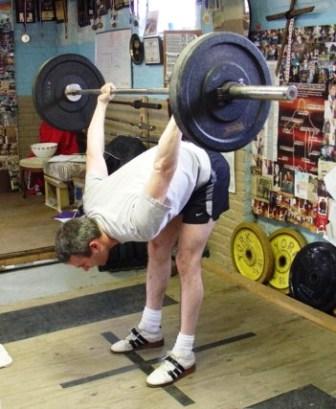Shoulder Flexibility Testing – Part 1
by Al Myers

Tim Piper performing a Kelly Snatch. This is an All Round Lift that requires great shoulder flexibility.
FLEXIBILITY – now that’s a word not often used in a weightlifters vocabulary. All of my life I have had this believe when it came to flexibility – “a little is good, but alot is a bad thing in regards to strength”. Now I know there are personal trainers out there who would wholeheartly disagree with me on this statement, but let me explain myself first. A big part of being strong (for max efforts lifts that is) is to “be tight” in the bottom position, or starting position, of a lift. Take the deadlift for example. As you descend to the bar, you want to feel like a spring where maximum compression occurs at the bottom starting position, and takes maximum flexibility to reach this point. Any flexibility beyond this does you no good, and probably is limiting your ability to “explode” from the bottom position. I have done training programs in the past where I trained standing on platforms to increase the range of motion on my deadlifts. I got stronger in those motions, and probably increase my deadlift flexibility, but guess what, my max deadlift off the floor did not increase! In fact, I felt “too loose” (and uncomfortable) in the bottom of a floor deadlift afterwards.
But I’m getting off topic here. Todays story is about shoulder flexibility. As I’ve got older I have noticed that the normal flexibility that I have taken for granted in the past is leaving me. My main problem area is with my shoulders. Too many years of bench pressing and front shoulder work is probably the culprit. I have the problem which I’m going to call the “tight shoulder syndrome”. I know many weightlifters have this same problem, especially as they become master lifters. Now the “tide has shifted”, and instead of decreased flexibility being your ally in increased strength, it has become your nemesis by limiting your range of motion in lifts that require more flexibility to complete them pain free.
Last weekend at the meet in Minneapolis I was asking David Dellanave about why his club was named The Movement. David explained to me that the reason for this was that they emphasize movements (or exercises) that increase functionality. Every exercise should have a beneficial component to increase the bodies ability to MOVE. He demonstrated this by doing a straight legged toe touch, and then after doing some stiff legged deadlifts, was able to show an increase in stretch in the toe touch AFTER the stiff legged deadlifts. That makes sense to me! I have been choosing exercises all my life that do the complete opposite!! The time has come that I need to start doing some exercises that will “shift the tide” back in my favor in regards to flexibility. I have decided to start this “experiment” with my shoulders as that is my biggest problem area.
One of my problems is that when I’m in the gym I have to have a specific goal in mind to motivate my training. Whether that be a meet coming up or a specific “challenge implement” in mind, I need that for my motivation. I have always done some stretching in the past, but often don’t focus on it like I should as there is no way of measuring my progress (or so I thought). I have done some internet research on shoulder flexibility and have come up with three Shoulder Flexibility Tests (2 very standard ones, and one original that I think is an important one for all rounders) that I would like to share with you. I am going to test myself on these, and then after some “training time” on shoulder flexibility retest myself and see what improvements I’ve made. If I don’t make progress, I’ll switch up my program until I find what works in regards to improving on these tests. That ought to be motivation! Tomorrow I’m going to reveal these tests so if you want to join me in this program you can.